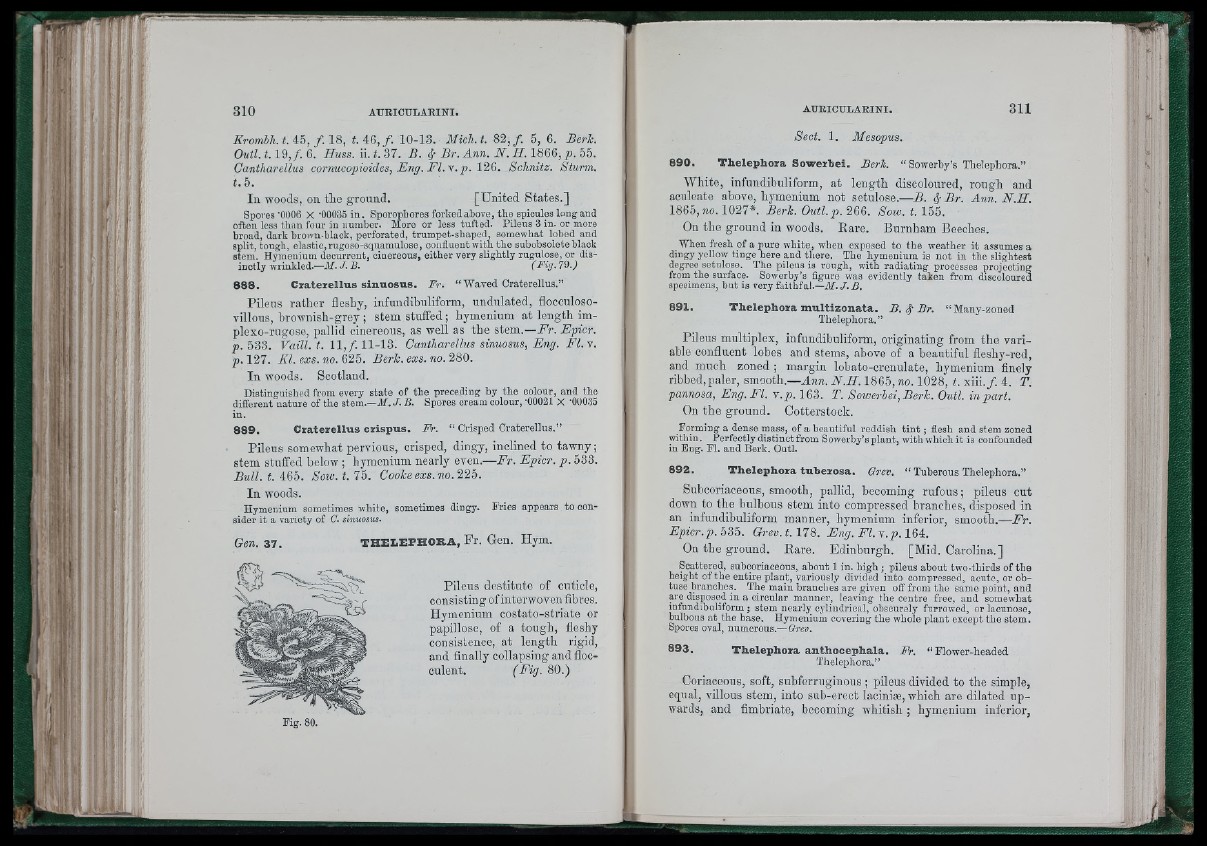
Kromhh. tA b , f . 18, t .4 6 ,f . 10-13. M k h .t. 82, f . b, 6. Berh.
Outl. 1.19,/. 6. Huss. ii. t. 37. B. 4 -Br- Ann. N . H. 1866, p. 55.
Cantharellus cornucopioides, Eng. F I .y .p . 126. Schnitz. Sturm,
t. 5.
In woods, on the ground. [United States.]
Spores'0006 X -00035 in. Sporophores forked above, the spicules long and
often less than four in number. More or less tufted. Pilens 3 in. or more
broad, dark brown-blaok, perforated, trumpet-shaped, somewhat [obed and
split, tough, elastic, rugoso-squamulose, confluent with the snbobsolete black
stem. Hymenium decnrrent, cinereous, either very slightly rugulose, or dis-
inctly wrinkled.—M .J .B . (Fig.7‘0.)
8 8 8 . C za te z e llu s s in u o su s . Fr. “ Waved Craterellus.”
Pileus rather fleshy, infundibuliform, undulated, flocculosovillous,
brownish-grey ; stem stuffed; bymenium at length im-
plexo-rngose, pallid cinereous, as well as the stem.—Dr. Epicr.
p. 533. Vaill. t. 11,/. 11-13. Cantharellus sinuosus, Eng. F I . y .
p . 121. Kl.e xs. no. 62b. Berh. exs. n o .280.
In woods. Scotland.
Distinguished from every state of the preceding by the colour, and the
different nature of the stem.—A/. J. B. Spores cream colour, -00021 X -00035
in.
8 8 9 . C za te z e llu s c z isp u s. Fr. “ Crisped Craterellus.”
Pileus somewhat pervious, crisped, dingy, inclined to tawny;
stem stnffed below ; hymenium nearly even.—Dr. Epicr. p . 533.
B u ll.t. 46b. Sow. t. lb . Coohe exs. no. 22b.
In woods.
Hymenium sometimes white, sometimes dingy. I ’ries appears to con-
sider it a variety of C. sinuosus»
Gen. 3 7 . TK E L E FH O R A , Fr. Gen. Hym.
Pileus destitute of cnticle,
consisting of interwoven fibres.
Hymenium costato-striate or
papillose, of a tough, fleshy
consistence, at length rigid,
and finally collapsing and flocculent.
(Fig. 80.)
Pig. 80.
Sect. 1. Mesopus.
8 9 0 . T h e lep h o z a So-wezbei. Berh. “ Sowerhy’s Thelephora.”
White, infundibuliform, a t length discoloured, rough and
aculeate aboye, hymenium not setulose.—B . 4 B r. Ann. N.H .
1865,»0.1027*. Berh. Outl.p. 266. Sow. t. 155.
On the ground in woods. Eare. Burnham Beeches.
When fresh of a pure white, when exposed to the weather it assumes a
dingy yellow tinge here and there. The hymenium is not iu the slightest
degree setulose. The pileus is rough, with radiating processes projecting
from^ the surface. Sowerby’s figure was evidently taken from discoloured
specimens, but is very faithful.—Ai. J. A.
891. T h e lep h o z a m u ltiz o n a ta .
Thelephora.”
B . 4 Br. “ Many-zoned
Pileus multiplex, infundibuliform, originating from the variable
confluent lobes and stems, above of a beautiful fleshy-red,
and much zoned ; margin lobato-crenulate, hymenium finely
ribbed,paler, smooth.—A n n .N .H . 1865,rao. 1028, t. x iii./. 4. T.
pannosa, E n g .F l. Y. p . 163. T. Sowerhei, Berh. Outl. in part.
On the ground. Cotterstock.
Forming a dense mate, of a beautiful reddish tin t ; flesh and stem zoned
within. Perfectly distinot from Sowerby’s plant, with which it is confounded
in Eng. Fl. and Berk. Outl.
8 9 2 . T h e lep h o z a tu b e zo sa . Orer. “ Tuberous Thelephora.”
Subcoriaeeons, smooth, pallid, becoming rufous ; pileus cut
down to tbe bulbous stem into compressed branches, disposed in
an infundibuliform manner, bymenium inferior, smooth.—Fr.
Epicr.p. 535. Orev. t. 178. Eng. Fl. Y.p . 164.
On the ground. Eare. Edinburgh. [Mid. Carolina.]
Scattered, subeoriaceous, about 1 in. high ; pileus about two-thirds of the
height of the entire plant, variously divided into compressed, acute, or obtuse
branches. The main branches are given off from the same point, and
are disposed in a circular manner, leaving the centre free, and somewhat
infundibuliform ; stem nearly cylindrical, obscurely furrowed, or lacunose,
bulbous at the base. Hymenium covering the whole plant except the stem.
Spores oval, numerous.—Grev.
8 9 3 . T h e lep h o za a n th o c ep h a la . Fr. “ Flower-headed
Thelephora.”
Coriaceous, soft, subferrnginous ; pileus divided to the simple,
eqnal, villous stem, into sub-erect laciniæ, wbicb are dilated upwards,
and fimbriate, becoming whitish ; bymenium inferior,